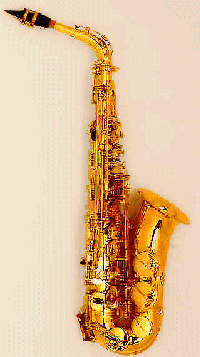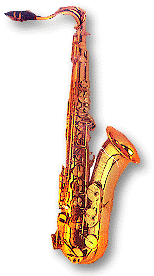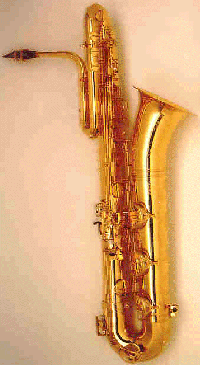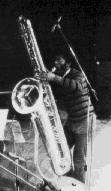

 The Sopranino saxophone
is the highest pitched of all saxophones. It playes one full octive
above the alto, and 2 higher then the baritone. The sopranino pictured
is a Selmer series II, model number 50. The sopranino isn't very
popular for many reasons, the lack of literiture and accessories, especially
reeds and mouthpieces, and that there many "big" names whom play this instrtument.
I would manly get this instrument for if you just want to fool around with
one. You can identify the sopranino from the soprano since it is
slightly smaller.
The Sopranino saxophone
is the highest pitched of all saxophones. It playes one full octive
above the alto, and 2 higher then the baritone. The sopranino pictured
is a Selmer series II, model number 50. The sopranino isn't very
popular for many reasons, the lack of literiture and accessories, especially
reeds and mouthpieces, and that there many "big" names whom play this instrtument.
I would manly get this instrument for if you just want to fool around with
one. You can identify the sopranino from the soprano since it is
slightly smaller.
 The Soprano saxophone
is the second highest pitched saxophone, second to the sopranino.
The soprano saxophone playes in the key of Bb, one octive higher then the
tenor, and two octives higher then the mighty bass saxophone. This
saxophone offers a medium sized range of literature, and a rather large
amount of available accessories, such as mouthpieces and reeds. This
saxophone has started gaining rather large appeal since the great Kenny
G started performing with it, if you have never heard Kenny play this beautiful
instrument, you are missing a lot. The soprano pictured is the Selmer
Series III, with a high F# key and a new high G key. Also,
the Selmer series III soprano has two necks, the normal straight neck,
and a more comfortable slightly bent neck. The soprano requires a
stronger embosure to play, much stronger then the alto or tenor saxophone's
"loose" embosure. Also I have been told that hitting notes in the
altissimo register is harder due to it's straight body. YOu can identify
the soprano from all the saxophones under it because it is generaly straight,
not curved like the alto tenor.
The Soprano saxophone
is the second highest pitched saxophone, second to the sopranino.
The soprano saxophone playes in the key of Bb, one octive higher then the
tenor, and two octives higher then the mighty bass saxophone. This
saxophone offers a medium sized range of literature, and a rather large
amount of available accessories, such as mouthpieces and reeds. This
saxophone has started gaining rather large appeal since the great Kenny
G started performing with it, if you have never heard Kenny play this beautiful
instrument, you are missing a lot. The soprano pictured is the Selmer
Series III, with a high F# key and a new high G key. Also,
the Selmer series III soprano has two necks, the normal straight neck,
and a more comfortable slightly bent neck. The soprano requires a
stronger embosure to play, much stronger then the alto or tenor saxophone's
"loose" embosure. Also I have been told that hitting notes in the
altissimo register is harder due to it's straight body. YOu can identify
the soprano from all the saxophones under it because it is generaly straight,
not curved like the alto tenor.
 The alto saxophone
is by far the most used and popular saxophone today. Usually the
alto saxophone is tought to the beginner to learn the basic ideas of the
saxophone, and then later plays multiple saxophones such as the tenor and
soprano. The alto has a nice mellow quality to it, one that many
people have grown to love. The alto has by far the most literature
and accessories ton offer, and many different brands of reeds and mouthpieces.
The alto plays in Eb, one octive below the sopranino, and one octive higher
then the baritone saxophone. One of the reasons the alto is so popular
is the fact that it is the middle saxophone, not to high and not to low.
Altissimo is easy to play on this instrument mainly due to the fact it
is curved. The saxoiphone pictured is the Selmer Series
II alto. The Selmer series II has a high F# key and many other features
that have become "sttandered". You can identiy the alto from the
tenor because it has a straight neck, not like the slight dip in the neck
of the tenor.
The alto saxophone
is by far the most used and popular saxophone today. Usually the
alto saxophone is tought to the beginner to learn the basic ideas of the
saxophone, and then later plays multiple saxophones such as the tenor and
soprano. The alto has a nice mellow quality to it, one that many
people have grown to love. The alto has by far the most literature
and accessories ton offer, and many different brands of reeds and mouthpieces.
The alto plays in Eb, one octive below the sopranino, and one octive higher
then the baritone saxophone. One of the reasons the alto is so popular
is the fact that it is the middle saxophone, not to high and not to low.
Altissimo is easy to play on this instrument mainly due to the fact it
is curved. The saxoiphone pictured is the Selmer Series
II alto. The Selmer series II has a high F# key and many other features
that have become "sttandered". You can identiy the alto from the
tenor because it has a straight neck, not like the slight dip in the neck
of the tenor.
 The straight alto
and tenor saxophone has the same charectoristics of their curved counterparts,
except they are straight. They were originally made in the 40's,
and have recently been made by L.A. Sax. The straight alto and tenor
saxophones e said to have a brighter sound, similar to the soprano.
The straight alto
and tenor saxophone has the same charectoristics of their curved counterparts,
except they are straight. They were originally made in the 40's,
and have recently been made by L.A. Sax. The straight alto and tenor
saxophones e said to have a brighter sound, similar to the soprano.
 The Tenor Saxophone
is usually called the jazz saxophone, altough it is ussed for all styles
of music. The tenor saxophone played in the key of Bb, one octive
lower then the Soprano, and one octive higher then the Bass saxophone.
Altissimo is very easily achieved on the tenor, due to it's size and shape.
A wide variety of literature and accesories are available for the tenor
saxophone, a close second to the alto saxophone. The saxophone pictured
is a Selmer Series III tenor with a high F# key, model 64. The series
III tenor has a neck simolar to the famous mark VI. You can tell
a Tenor fom an alto saxophone simply by looking at the neck, the tenor
has a slight bend in it.
The Tenor Saxophone
is usually called the jazz saxophone, altough it is ussed for all styles
of music. The tenor saxophone played in the key of Bb, one octive
lower then the Soprano, and one octive higher then the Bass saxophone.
Altissimo is very easily achieved on the tenor, due to it's size and shape.
A wide variety of literature and accesories are available for the tenor
saxophone, a close second to the alto saxophone. The saxophone pictured
is a Selmer Series III tenor with a high F# key, model 64. The series
III tenor has a neck simolar to the famous mark VI. You can tell
a Tenor fom an alto saxophone simply by looking at the neck, the tenor
has a slight bend in it.
 The baritone saxophone
plays in the key of Eb, one octive lower then the alto saxophone, and two
octives lower then the sopranino. The baritone saxophone is usually
used in jazz ensambles, but can be used in other types of music as well.
The baritone does have a variety of accessories, as well as mouthpieces
and reeds, but these can get costly. The baritone saxophone pictured
is a Selmer series II. You can identify the baritone from the saxophones
that play in the higher keys because of the looped neck.
The baritone saxophone
plays in the key of Eb, one octive lower then the alto saxophone, and two
octives lower then the sopranino. The baritone saxophone is usually
used in jazz ensambles, but can be used in other types of music as well.
The baritone does have a variety of accessories, as well as mouthpieces
and reeds, but these can get costly. The baritone saxophone pictured
is a Selmer series II. You can identify the baritone from the saxophones
that play in the higher keys because of the looped neck.
 The bass saxophone
is the largest saxophone that is still made today. It playes in the
key of Bb, one octive lower then the tenor, two octives lower then the
soprano. The bass saxophone lacks both writen music, accesories,
mouthpieces and reeds. The bass saxophone pictured is a Selmer series
II. If you get one of these, get ready to pay a lot of money, these
saxophones are hard to come by, usually special ordered, and have a lot
of metal in them so obviusly, they are EXPENSIVE. You can identify
the bass saxophone from the baritone sax simply by the curve in the neck
being much larger on the bass, and the saxophone in general is larger.
The bass saxophone
is the largest saxophone that is still made today. It playes in the
key of Bb, one octive lower then the tenor, two octives lower then the
soprano. The bass saxophone lacks both writen music, accesories,
mouthpieces and reeds. The bass saxophone pictured is a Selmer series
II. If you get one of these, get ready to pay a lot of money, these
saxophones are hard to come by, usually special ordered, and have a lot
of metal in them so obviusly, they are EXPENSIVE. You can identify
the bass saxophone from the baritone sax simply by the curve in the neck
being much larger on the bass, and the saxophone in general is larger.
 Only 17 contrabass
saxophones are believed to be in existence today. One of the only
companies that made this monsteris instrument was Conn. I believe
it plays in the key of Eb, but I may be wrong. If you want to hear
what this sounds like, a few small saxophone ensambles use the contrabass
saxophone. One of them is the Nucleus Whales. The Contrabass
saxophone has very little use now-a-days. It is just amazing how
large these instruments are. Of course written music and accessories,
mouthpieces, and reeds literally don't exist to my knowledge. You
can identify the Contrabass from the other saxophones mainly because of
it's size. Also the curve in the neck is VERY large. Recently,
LA Sax has reintroduced this instrument,
at a coast of around $37,000.
Only 17 contrabass
saxophones are believed to be in existence today. One of the only
companies that made this monsteris instrument was Conn. I believe
it plays in the key of Eb, but I may be wrong. If you want to hear
what this sounds like, a few small saxophone ensambles use the contrabass
saxophone. One of them is the Nucleus Whales. The Contrabass
saxophone has very little use now-a-days. It is just amazing how
large these instruments are. Of course written music and accessories,
mouthpieces, and reeds literally don't exist to my knowledge. You
can identify the Contrabass from the other saxophones mainly because of
it's size. Also the curve in the neck is VERY large. Recently,
LA Sax has reintroduced this instrument,
at a coast of around $37,000.
 The Sub-Contrabass
Saxophone is the largest saxophone in existence. About three are
believed to have been made, one was for the 1899 Paris Expositioin.
It was built by Avions Bleriot, and is in the key of C. Quit obviusly,
the Sub-Contrabass saxophone has little use, except for show. It
is much to large to move easily, and it takes at least 3 people to play.
There is an on-gowing debat as to if any of the sub-contrabass saxes were
ever playable, but they are still quite marvolus to see.
The Sub-Contrabass
Saxophone is the largest saxophone in existence. About three are
believed to have been made, one was for the 1899 Paris Expositioin.
It was built by Avions Bleriot, and is in the key of C. Quit obviusly,
the Sub-Contrabass saxophone has little use, except for show. It
is much to large to move easily, and it takes at least 3 people to play.
There is an on-gowing debat as to if any of the sub-contrabass saxes were
ever playable, but they are still quite marvolus to see.